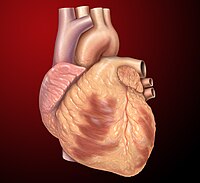
Photo from wikipedia
Gentiopicroside (GPS), a main active secoiridoid glucoside derived from the roots of perennial herbs in the Gentianaceae family, has antispasmodic and relaxant effects. However, the vasorelaxant effects of GPS on… Click to show full abstract
Gentiopicroside (GPS), a main active secoiridoid glucoside derived from the roots of perennial herbs in the Gentianaceae family, has antispasmodic and relaxant effects. However, the vasorelaxant effects of GPS on aortic rings and the molecular mechanisms involved in these effects are not yet clear. Therefore, we investigated whether GPS inhibits phenylephrine- (PE-) or KCl-induced contractions in isolated rat thoracic aortic rings. The present study found that GPS produced a dose-dependent relaxation in aortic rings precontracted with PE or KCl and significantly reduced CaCl2-, narciclasine- (Rho-kinase activator-), and phorbol-12,13-diacetate- (PKC activator-) induced vasocontractions. Pretreatment with NG-Nitroarginine methyl ester hydrochloride (L-NAME, NOS inhibitor), methylene blue (sGC inhibitor), indomethacin (COX inhibitor), 4-aminopyridine (KV channel inhibitor), and glibenclamide (KATP channel inhibitor) had no influence on the vasorelaxant effect of GPS, while BaCl2 (Kir channel inhibitor), tetraethylammonium chloride (KCa channel inhibitor), ruthenium red (RYR inhibitor), and heparin (IP3R inhibitor) significantly reduced GPS-induced vasorelaxation. Moreover, GPS pretreatment remarkably inhibited the influx of Ca2+ in vascular smooth muscle cells stimulated using KCl or PE-containing CaCl2 solution. Western blot analysis confirmed that GPS treatment inhibited PE-induced increases in the protein levels of p-Akt, p-myosin light chain (MLC), and p-myosin-binding subunit of myosin phosphatase 1 (MYPT1) in the aortic rings. Additionally, the vasorelaxation activity of GPS was attenuated upon pretreatment with LY294002 (PI3K/Akt inhibitor), Y27632 (Rho-kinase inhibitor), and verapamil (L-type Ca2+ channel inhibitor). These findings demonstrate that GPS exhibits endothelium-independent vasorelaxant effects through inhibition of voltage-dependent, receptor-operated, and inositol triphosphate receptor (IP3R)/ryanodine receptor- (RYR-) mediated Ca2+ channels as well as the PI3K/Akt/Rho-kinase signaling pathway.
Journal Title: BioMed Research International
Year Published: 2021
Link to full text (if available)
Share on Social Media: Sign Up to like & get
recommendations!